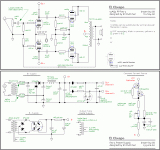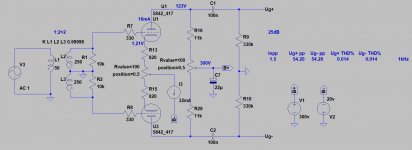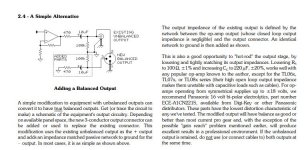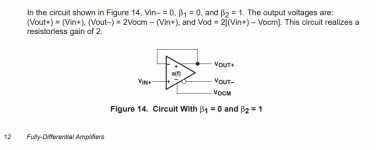Assuming you have a simple single tube SE stage in a preamp, what are all the possible ways of converting the SE output to balanced/PP?
- transformer
- concertina
- mosfet splitter
- other?
What are the advantages and drawbacks of these various solutions? There's also going to be a cost differential between valves/mosfets and a good output transformer.
Schematics would be very welcome as illustrations of the different methods.
- transformer
- concertina
- mosfet splitter
- other?
What are the advantages and drawbacks of these various solutions? There's also going to be a cost differential between valves/mosfets and a good output transformer.
Schematics would be very welcome as illustrations of the different methods.
Output level ?
(From the se tube)
Gain structure ?
Step down ? Stepup ? Or none of them?
Assume a triode with a mu of between 20 and 60, or a DHT with a mu of around 9.
Step-down could be useful for a higher mu tube or to get a very low output impedance. I assume this means a transformer, but I'd like to know other ways of doing it. It would be interesting to have choices for both step-down and no step-down.
The "concertina", AKA cathodyne, AKA split load, phase splitter can be implemented with either a triode or a FET. DC coupling an enhancement mode MOSFET to the preceding vacuum voltage amplifier is quite easy. As it is a variation on the voltage follower theme, the "concertina" phase splitter exhibits a small voltage insertion loss.
A differential amplifier (AKA long tailed pair [LTP]), which does have some voltage gain, is quite flexible and can be used to go from SE to PP/bal. or the other way around.
As requested, some schematics showing the above mentioned circuit types in the PP power amplifier phase splitter role are provided.
A differential amplifier (AKA long tailed pair [LTP]), which does have some voltage gain, is quite flexible and can be used to go from SE to PP/bal. or the other way around.
As requested, some schematics showing the above mentioned circuit types in the PP power amplifier phase splitter role are provided.
Attachments
The "concertina", AKA cathodyne, AKA split load, phase splitter can be implemented with either a triode or a FET. DC coupling an enhancement mode MOSFET to the preceding vacuum voltage amplifier is quite easy. As it is a variation on the voltage follower theme, the "concertina" phase splitter exhibits a small voltage insertion loss.
Thanks Eli. I've built both LTPs and concertinas, but never a Mosfet splitter. It looks quite straightforward. I'm very unfamiliar with solid state but this doesn't look like it's complicated, as long as it doesn't oscillate or misbehave in other ways. No doubt there are various potential Mosfet choices here.
Andy,
As long as you don't try to get voltage gain out of them, MOSFETs can be very useful. What makes a MOSFET good for use in hybrid circuitry is a low and "stable" reverse transfer capacitance (Crss). If Crss is substantial, HF info. gets shorted to ground.
The 2 FETs I keep returning to are the ZVN0545A, which wimpy types drive easily, and the IRFBC20. Scads of parts are present in the catalog and I'm sure some whose Crss is suitable and also have a built in gate protective Zener diode can be identified.
Read MOSFET Follies.
As long as you don't try to get voltage gain out of them, MOSFETs can be very useful. What makes a MOSFET good for use in hybrid circuitry is a low and "stable" reverse transfer capacitance (Crss). If Crss is substantial, HF info. gets shorted to ground.
The 2 FETs I keep returning to are the ZVN0545A, which wimpy types drive easily, and the IRFBC20. Scads of parts are present in the catalog and I'm sure some whose Crss is suitable and also have a built in gate protective Zener diode can be identified.
Read MOSFET Follies.
Mu 20-60 vs mu 9 are different beastsAssume a triode with a mu of between 20 and 60, or a DHT with a mu of around 9.
Step-down could be useful for a higher mu tube or to get a very low output impedance. I assume this means a transformer, but I'd like to know other ways of doing it. It would be interesting to have choices for both step-down and no step-down.
Requiering different solution . I would suggest optimizing not generalising
Mu 20-60 vs mu 9 are different beasts
Requiering different solution . I would suggest optimizing not generalising
OK assume a triode with a mu of 9-20. DHT or indirectly heated.
Good transformer is hard to beat, but it will only work with low to medium mu tubes. "Good" means symmetry, Faraday shield, and low leakage inductance between secondary halves.
As an alternative, SE-SE transformer with floating secondary can be used as SE-PP interface. Such transformer may have sectioned secondary for volume control.
UTC transformers A-17, A-19 (interstage), A-25 and HA-133 (plate to balanced line) are examples of good phase splitting transformers.
As an alternative, SE-SE transformer with floating secondary can be used as SE-PP interface. Such transformer may have sectioned secondary for volume control.
UTC transformers A-17, A-19 (interstage), A-25 and HA-133 (plate to balanced line) are examples of good phase splitting transformers.
How much output level do you want?
The required output swing determine the gain of the driver stage, which limits the usable tubes (in case of the single stage), and specify that input step up transformer requiring or not.
The required output swing determine the gain of the driver stage, which limits the usable tubes (in case of the single stage), and specify that input step up transformer requiring or not.
Attachments
Last edited:
If you are considering a MOSFET for splitter, the LND150 is ok too.
"A good candidate to emulate Triodes at high voltage is the Supertex LND150 depletion mode mosfet. This NMOS fet is available at Mouser and Digikey ($.50 ea), and takes up to 500V with 1mS of transconductance. This makes a good candidate to emulate a 12AX7."
I have "made" a SS 6SL7 and a 12AX7 using two of these cheap mosfets soldered into empty bases and filled with hot wax. No heaters worries!! But this was in a guitar amp...
Whoops - just realized that 12AX7 makes a crappy phase splitter....
"A good candidate to emulate Triodes at high voltage is the Supertex LND150 depletion mode mosfet. This NMOS fet is available at Mouser and Digikey ($.50 ea), and takes up to 500V with 1mS of transconductance. This makes a good candidate to emulate a 12AX7."
I have "made" a SS 6SL7 and a 12AX7 using two of these cheap mosfets soldered into empty bases and filled with hot wax. No heaters worries!! But this was in a guitar amp...
Whoops - just realized that 12AX7 makes a crappy phase splitter....
Last edited:
How much output level do you want?
The required output swing determine the gain of the driver stage, which limits the usable tubes (in case of the single stage), and specify that input step up transformer requiring or not.
The output level isn't critical. There would be a volume control on the preamp input. The purpose would be feeding an amplifier with balanced inputs. Actually it's not for my use (at the moment) but somebody asked about building a preamp with SE in and balanced out.
In fact ideally it would have both SE and balanced outputs.
The output level isn't critical. There would be a volume control on the preamp input. The purpose would be feeding an amplifier with balanced inputs. Actually it's not for my use (at the moment) but somebody asked about building a preamp with SE in and balanced out.
In fact ideally it would have both SE and balanced outputs.
Andy,
Is there a chance that the SE and balanced O/Ps will be in use simultaneously? If so, I envisage sophisticated buffering techniques being quite necessary.
Or maybe he can just get a single ended to split phase balanced output transformer, to make it yourself.
https://www.jensen-transformers.com/wp-content/uploads/2014/08/as060.pdf
https://www.jensen-transformers.com/wp-content/uploads/2014/08/as060.pdf
Last edited:
Is there a chance that the SE and balanced O/Ps will be in use simultaneously? If so, I envisage sophisticated buffering techniques being quite necessary.
No, that wouldn't be necessary. Either/or outputs.
Incidentally I don't really understand the op-amp circuit. I'm not getting how the signal ground (op-amp) and main ground work together. For instance, without the op-amp I don't see it working at all, and I don't need extra gain.
For signals up to 24Vpp, fully differential op amp such as opa1632 and ths4131 would be simplest, needs +/- 15V supply. From https://www.ti.com/lit/an/sloa054e/sloa054e.pdf page 12. Simply ground Vocm pin.
Attachments
I recently put together something essentially like that. A simple circuit of 6SN7 running into Sowter 1367s with 200V B+ ish at 8.5mA works really well with a little bit of gain and low output impedance. You could wire balanced and single ended outputs from the transformers assuming they weren't ever going to be used together.
If you could accept parafeed type arrangement then using a PP Output transformer as a phase splitting choke brings considerable benefits over a transformer in the same arrangement. Frequency response is considerably extended and the potential for ringing reduced.
Alternatively input phase splitting transformers are generally cheaper and higher performance than output splitting transformers.
Shoog
Alternatively input phase splitting transformers are generally cheaper and higher performance than output splitting transformers.
Shoog
If you could accept parafeed type arrangement then using a PP Output transformer as a phase splitting choke brings considerable benefits over a transformer in the same arrangement. Frequency response is considerably extended and the potential for ringing reduced. Shoog
This is a good idea. I have a pair of Hammond 124B transformers which are 90K CT:10K. This would give a 3 to 1 step-down. It would then be necessary to use a virtual centre tap on the output.
I searched for some schematics of this but couldn't find any. So what value resistors should I be using? And is this going to give a 3:1+1 ratio?
- Home
- Amplifiers
- Tubes / Valves
- Preamp output - SE to balanced choices?




